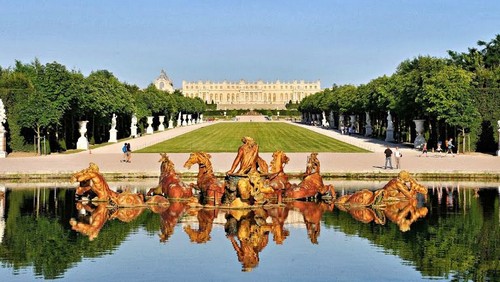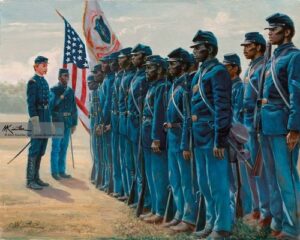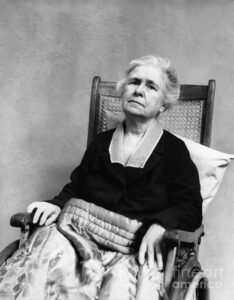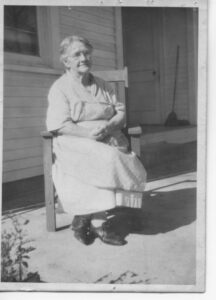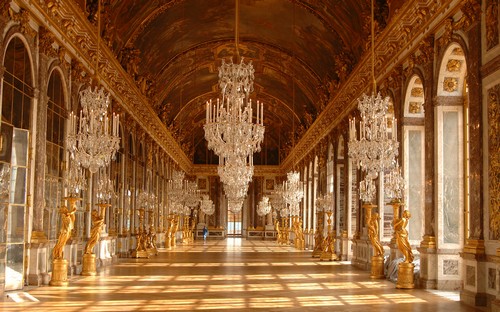
Versailles was built in 1631, first used as a hunting lodge by Louis XIV. He wanted his new residence to be farther away from the capital. Versailles is located about nine miles outside the capital, being just far so local riots wouldn’t harm the royal family or their residence, but close enough to still be able to distinguish riots and host the aristocracy who lived within the city.
Versailles then was renovated, making it the epidemy of art and beauty in French Architecture. Versailles has almost 135 rooms, all from the royal apartments of the King himself, to the lowest servant who lived in a closet behind the staircase.
The architecture of the palace was centered on showing how rich France was and how the king was the center of France. In most of the art in the palace and the many structures and statues of the palace, we see the king depicted as the god Apollo, or as the king being the center of a painting, or him being depicted as the sun. The king wanted himself to be known as the center of all life in the French empire, all he did was watch and oversee.
He was watched every second of the day, everything he did had an audience of courtiers and guests of the palace. He was awoken in the morning by servants, his old nanny kissing him on the cheek to wake him up. Every morning she did this for fifty years. The courtiers then came in one by one, bringing with them the necessary supplies to get the king ready. This was a special occasion, and the courtiers were honored to even bring the king his mirror or other such mundane tasks, which became high privileges in the palace of Versailles. Courtiers gained favor with the king, which made them higher in rank among the residents of the palace, which gained him additional privileges and better apartments in the palace. We can also see how the king was the center of all life at Versailles because he was on the highest floor, and had the most chambers. The more honored and favored guests and courtiers had apartments closest to him, and the closer you were to the king’s own chambers the more highly honored and privileged you were among the other residents of the palace.
Not only was getting the king ready for a special occasion but the king’s dining was also watched by a large audience. He would eat, and the many courtiers and guests would stand and make conversation with the king as he ate. The king loved an audience, and an audience was what he got. Personal affairs were also overseen by courtiers and a multitude of other men and women. A royal birth was a large affair, often a hundred people or more crowded into the bed chambers of the queen, so that they could witness the birth of the next royal prince or princess. They not only did this to be witnesses of such a spectacle but also because they were supposed to make sure the baby was not switched out at birth with another baby, for political or health reasons I would assume.
The palace was not all beautiful architecture and luxury though. Although the structure was magnificent and the appearance of the palace was awe-striking, the appearance was all it had. It is recorded that the palace stunk of human refuse and urine. Since there were really not adequate plumbing systems at the time, people used chamber pots. Even though the king and queen might have personal ‘closets’, which were rooms that held a closing stool, which was a chamber pot but concealed in a stool so that the stench would not escape, the other courtiers and guests had normal chamber pots, which were pots that people relieved themselves in and servants then would take and dump them. This was not a great system though, because, with hundreds of rooms and guests, servants could clean all of the chamber pots as soon as they were relieved. This meant that the stench would grow the longer the chamber pots sat, filling the apartments of the palace. The outside stunk as well because the palace of Versailles was open to the public, and the peasants and townsfolk dumped their trash on the outside of the palace grounds, which was not taken care of often by the servants of the palace. This meant that the palace and the grounds smelled absolutely terrible.
Having chamber pots in the rooms also meant that there were no public bathrooms around the palace, only the king himself and his queen had their own personal closets. The courtiers and the residents of the palace couldn’t travel all the way to their quarters in they needed to relieve themselves, so they relieved themselves wherever they could. They would find a corner or even off a balcony or on a wall, even in plain sight of others. With women though, it was more discreet, because they had large gowns that they could slip a chamber pot under or a bowl of some sort in which they could do their business, then slip out from under their skirts when they were done. This meant that the entire palace stunk, people, using the bathroom wherever they could, and when chamberpots were emptied, servants sometimes just dumped the refuse out the window, not even having the decency to tell people walking below to watch out, sometimes dumping the contents of the chamber pots on people below.
Because of the horrid stench of the place, the people coated themselves with perfume. This was essential for the residents living inside the palace. The residents of the palace also didn’t bathe. They ‘dry’ bathed, which meant they wiped themselves down without using water, but instead some sort of solvent or soap, but without water. They believed that water would open your pores, and when this happened, you could lose your humors and they would become unbalanced, making you susceptible to diseases and sicknesses. They also did not wash their hair or their private parts, so they covered their hair with powder, much like dry shampoo, and they put smelling herbs on themselves. With this lack of cleanliness in the residents came added stench to the palace. As we can see, appearance was key. What they lacked in hygiene they made up in the dress. They were clothed to the last pin in French cloth and linen. They were magnificently clothed in french style and fine garments. Because of the lack of hygiene, people were known to change their clothes at various times throughout the day to get rid of stench or dust.
The conditions of Versailles didn’t last this way, and when Louis XV came into power, he installed a permanent bathtub in his apartments and bathed regularly. In the 1700s the palace became more hygienic.
Although the palace might have smelled considerably strong of refuse and trash during the time of King Louie XIV, the appearance of the palace was truly magnificent. The gardens were kept clean and cultivated. The fountains within the gardens were beautiful, but the fountains were only turned on during special events because the plumbing was not adequate to sustain long periods of running the fountains. Because of the stench of the palace, the king perfumed not only the people within the castle but the water in the fountains. The king was known to have the water essenced with orange blossom, because that was his favorite scent, and because he had a whole garden of orange trees that were from China. Later on in life, the king hated the strong perfumes of the women in the castle because it gave him migraines and headaches.
The Palace was beautiful, but it cost the French millions of dollars to build, depleting the French treasury. This led to the fall of the French empire, which led to the French revolution. The people were starving and were suffering while the French king and the aristocracy were lived pampered lives within the walls of Versailles. The king had spent so much money on the palace that the people became outraged. The Aristocracy was living in luxury and with food in their stomachs while the French people struggled to survive. The infuriated people of France rose up and attacked the castle, bringing the king and queen to Paris where they were beheaded. The other aristocrats were also beheaded, with few escaping the executions of the aristocracy and the royals. This led to a new of France, the country of France becoming a Republic rather than a monarchy.
In this article, we saw how the palace was built, and how magnificent the palace was. We learned about the lives of the residents within the palace and about the living conditions as well. We learned about the habits of the king and his courtiers, and what their jobs were. We also saw how the building of this great palace provoked the French people to action, which led to the French Revolution and the fall of the Monarchy. From the ashes of the monarchy and the aristocracy came the Republic of France.
I hope that this article was informative and that you were able to learn more about the French Revolution through studying the Monarchy. I really enjoyed writing this article, and I will hopefully be writing more like this. Again, I thank you all for reading this blog, and I hope you continue to find the articles entertaining and informative. Thanks! – Sadie

